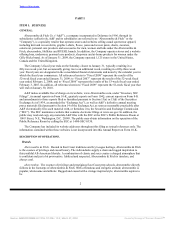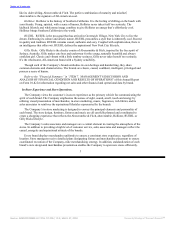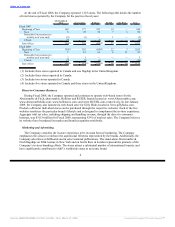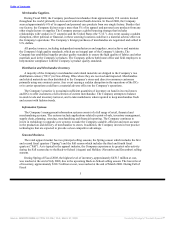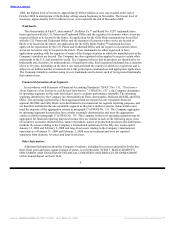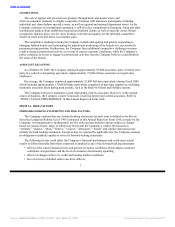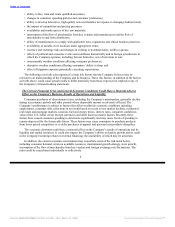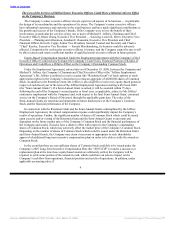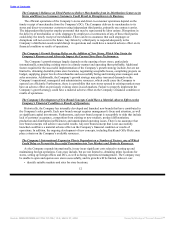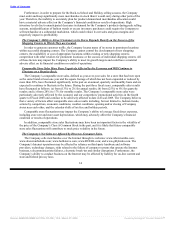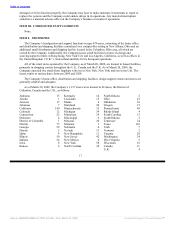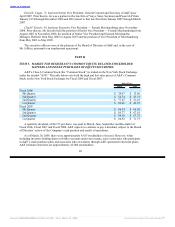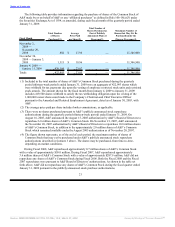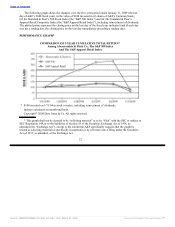Abercrombie & Fitch 2008 Annual Report Download - page 14
Download and view the complete annual report
Please find page 14 of the 2008 Abercrombie & Fitch annual report below. You can navigate through the pages in the report by either clicking on the pages listed below, or by using the keyword search tool below to find specific information within the annual report.
Table of Contents
The Company’s Reliance on Third Parties to Deliver Merchandise from its Distribution Centers to its
Stores and Direct-to-Consumer Customers Could Result in Disruptions to its Business.
The efficient operations of the Company’s stores and direct-to-consumer operations depend on the
timely receipt of merchandise from the Company’s DCs. The Company delivers its merchandise to its
stores and direct-to-consumer customers using independent third parties, primarily one contract carrier.
The independent third parties employ personnel that may be represented by labor unions. Disruptions in
the delivery of merchandise or work stoppages by employees or contractors of any of these third parties
could delay the timely receipt of merchandise. There can be no assurance that such stoppages or
disruptions will not occur in the future. Any failure by a third party to respond adequately to the
Company’s distribution needs would disrupt its operations and could have a material adverse effect on its
financial condition or results of operations.
The Company’s Growth Strategy Relies on the Addition of New Stores, Which May Strain the
Company’s Resources and Adversely Impact the Current Store Base Performance.
The Company’s growth strategy largely depends on the opening of new stores, particularly
internationally, remodeling existing stores in a timely manner and operating them profitably. Additional
factors required for the successful implementation of the Company’s growth strategy include, but are not
limited to, obtaining desirable prime store locations, negotiating acceptable leases, completing projects on
budget, supplying proper levels of merchandise and successfully hiring and training store managers and
sales associates. Additionally, the Company’s growth strategy may place increased demands on the
Company’s operational, managerial and administrative resources, which could cause the Company to
operate less efficiently. Furthermore, there is a possibility that new stores opened in existing markets may
have an adverse effect on previously existing stores in such markets. Failure to properly implement the
Company’s growth strategy could have a material adverse effect on the Company’s financial condition or
results of operations.
The Company’s Development of New Brand Concepts Could Have a Material Adverse Effect on the
Company’s Financial Condition or Results of Operations.
Historically, the Company has internally developed and launched new brands that have contributed to
the Company’s sales growth. Each new brand concept requires management’s focus and attention, as well
as significant capital investments. Furthermore, each new brand concept is susceptible to risks that include
lack of customer acceptance, competition from existing or new retailers, product differentiation,
production and distribution inefficiencies and unanticipated operating issues. There is no assurance that
new brand concepts will achieve successful results. Any new brand concept that is not successfully
launched could have a material adverse effect on the Company’s financial condition or results of
operations. In addition, the ongoing development of new concepts, including Ruehl and Gilly Hicks, may
place a strain on the Company’s available resources.
The Company’s International Expansion Plan is Dependent on a Number of Factors, any of Which
Could Delay or Prevent the Successful Penetration into New Markets and Strain its Resources.
As the Company expands internationally, it may incur significant costs related to starting up and
maintaining foreign operations. Costs may include, but are not limited to, obtaining prime locations for
stores, setting up foreign offices and DCs, as well as hiring experienced management. The Company may
be unable to open and operate new stores successfully, and its growth will be limited, unless it can:
• identify suitable markets and sites for store locations;
12
Source: ABERCROMBIE & FITCH CO /DE/, 10-K, March 27, 2009 Powered by Morningstar® Document Research℠


